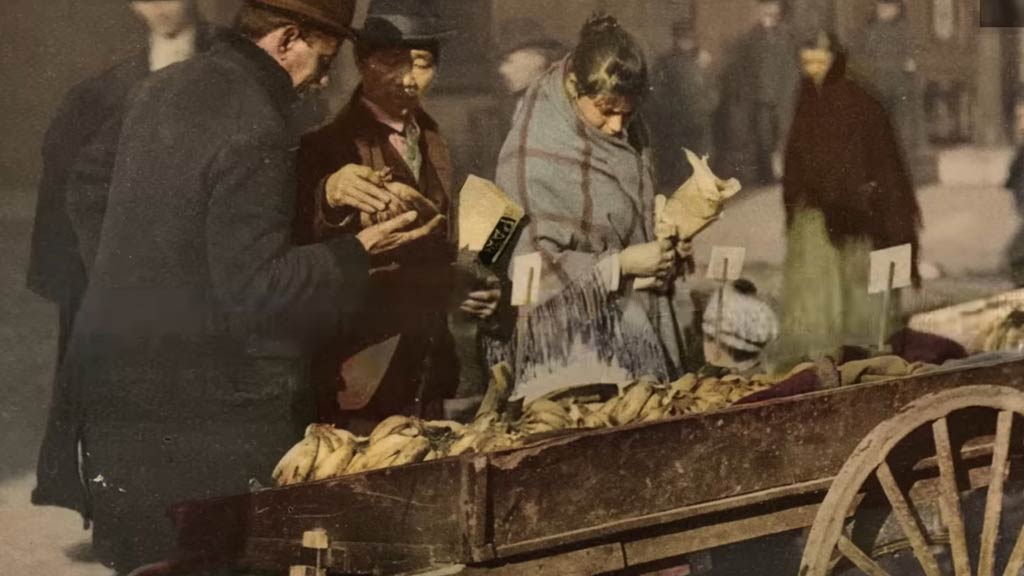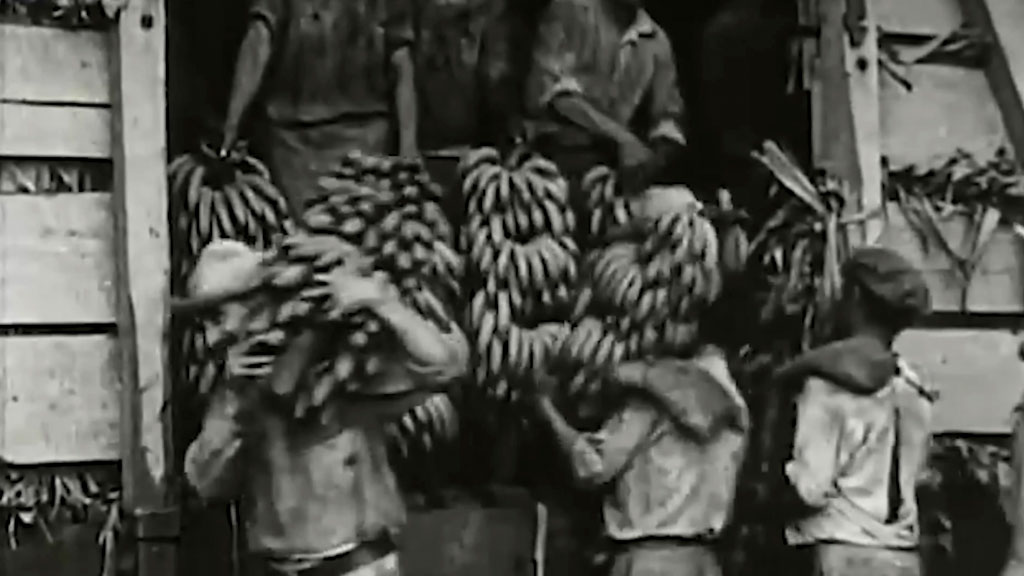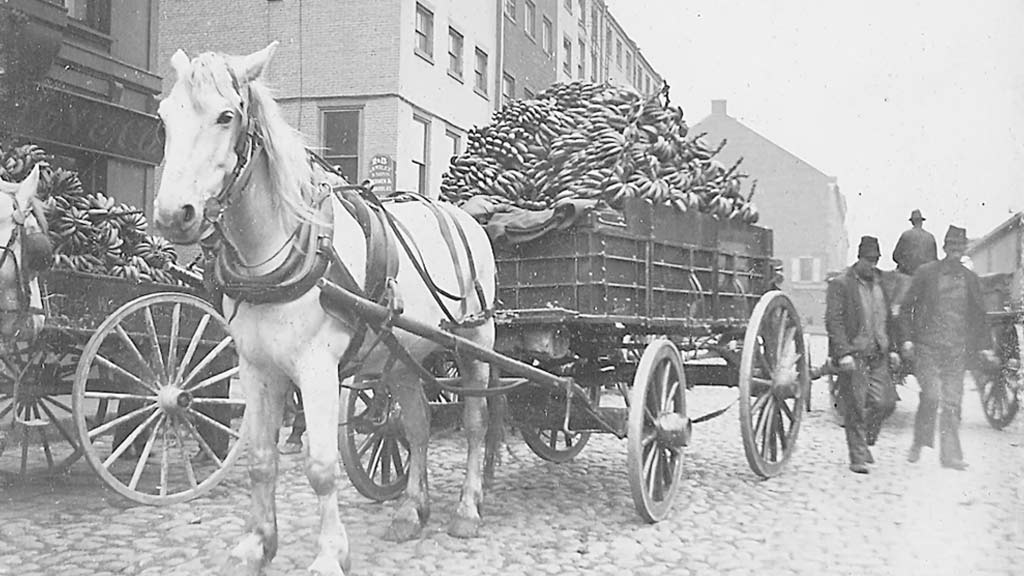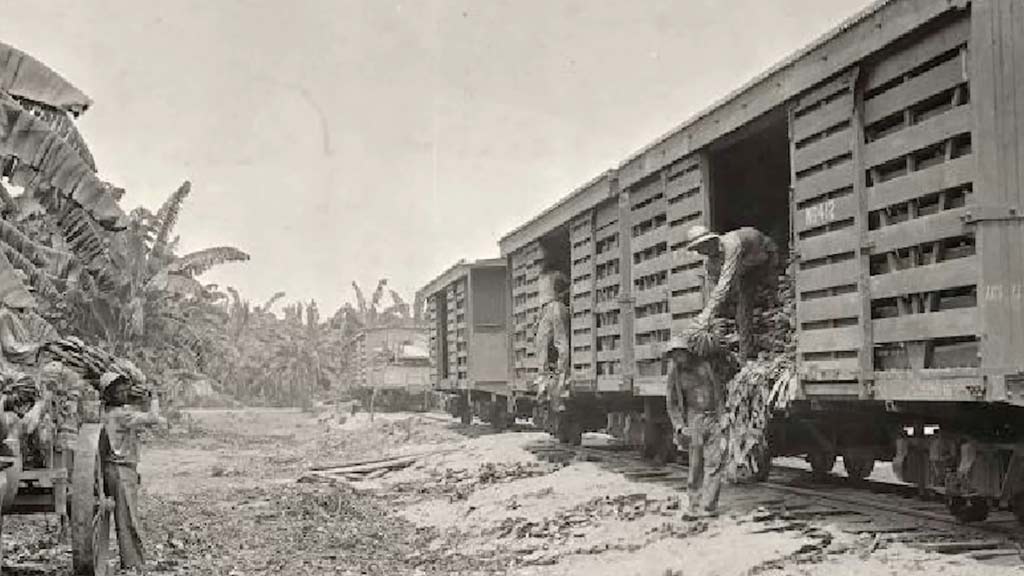When you’ve ever savored a sweet, ripe banana, you’re part of a historical love affair that dates back to the late nineteenth century.
Back then, bunches of Gros Michel bananas were making their way to ports in New Jersey, Philadelphia, and Boston, captivating Americans with their desirable taste and affordable price.
This newfound obsession led to the formation of the Boston Fruit Company in 1885 by a Cape Cod ship captain and a Boston grocery worker, marking the birth of the first commercial banana enterprise.
Renamed the United Fruit Company by 1930, this banana giant soared in value, exceeding 200 million dollars.
The dark and intriguing history of this company, along with other early exporters, is chronicled in works like John Soluri’s “Banana Cultures” and Dan Koeppel’s “Banana.”
As the Gros Michel banana thrived in various tropical regions, by 1913, Americans were consuming an average of over twenty pounds of bananas per person annually, shaping not just Boston’s history, but the nation’s love affair with this tropical fruit.
Historical Background of Bananas
Bananas have an intriguing historical background, and their introduction to Boston, like many other parts of the world, is quite fascinating.
Here’s an overview:
Origin of Bananas

Bananas made their debut in the United States in 1870 when Lorenzo Dow Baker, captain of the schooner Telegraph, brought them from Jamaica to Boston, selling them at a substantial profit.
This tropical fruit quickly captivated Americans due to its affordability compared to local fruits like apples. As early as 1913, a dozen bananas could be bought for 25 cents, a fraction of the price of just two apples.
This marked the beginning of a lucrative industry that would shape American consumption patterns.
Bananas Introduction to Boston
The introduction of bananas to Boston paved the way for a new era in the fruit market. In 1873, Henry Meiggs and Minor C. Keith, American railroad tycoons, established banana plantations in Costa Rica to provide food for their railroad workers.
Recognizing the profitability of exporting bananas, they began shipping the fruit to the Southeastern United States.
This strategic move not only fueled the growth of the banana industry but also transformed the way Americans viewed and consumed tropical fruits.
Boston’s Relation with Bananas
Boston has a deep and enduring relationship with bananas, shaped by historical, economic, and cultural factors.
Here are the key aspects of Boston’s connection with bananas:
Economic Impact

Boston’s connection with bananas had a profound economic impact on the city. The arrival of bananas from Latin America created new avenues for trade and commerce, significantly boosting Boston’s economy.
With the rise of the banana industry, Boston became a key player in the import and distribution of this tropical fruit.
The demand for bananas led to the establishment of various fruit companies and shipping routes that further solidified Boston’s position as a hub for banana trade.
The economic prosperity brought by bananas not only benefited local businesses but also contributed to the overall growth and development of the city’s economy.
Influence on Local Culture
The introduction of bananas in Boston had a transformative effect on the local culture. This exotic fruit quickly became a staple in Bostonians’ diets, adding a tropical flair to their culinary preferences.
The availability of bananas not only diversified the food choices in Boston but also introduced new flavors and recipes to the local cuisine.
Moreover, the popularity of bananas in Boston influenced cultural practices and traditions, creating a lasting impact on the city’s culinary landscape.
The incorporation of bananas into everyday life reflected a broader cultural shift, symbolizing the fusion of diverse food traditions and the exploration of global culinary influences within the local community.
Boston Fruit Company and Bananas
The Boston Fruit Company played a crucial role in the distribution and popularization of bananas in Boston and beyond.
Here’s an overview of its significance:
Evolution Over the Years

Established in 1885, the Boston Fruit Company marked a pivotal moment in the history of banana trade in the United States.
By 1890, it had emerged as the most successful banana company in the country, showcasing remarkable growth from an initial investment of $15,000 to $531,000. How did this evolution unfold?
Boston Fruit Company revamped the transportation of bananas by substituting sailing vessels with steamships, procuring two of the fastest cargo ships in the Caribbean.
Additionally, the company strategically invested in extensive banana plantations in Jamaica, guaranteeing a consistent supply of over 250,000 stems annually by 1890.
Influence on Banana Trade
The success of the Boston Fruit Company not only transformed the banana trade industry but also had a profound impact on the economic landscape.
By pioneering innovative transport methods and securing a stable source of bananas through plantations, the company set a new standard for banana trade efficiency and productivity.
Boston Fruit Company’s influence extended beyond transportation and supply stability. The establishment of banana plantations in Jamaica not only ensured a robust supply chain but also contributed significantly to the growth of the banana trade in the region.
This strategic move solidified the company’s position as a key player in the global banana market, shaping the trajectory of banana trade for years to come.
Representation of Bananas in Boston Art and Literature
Bananas have been represented in various forms of art and literature in Boston, reflecting their cultural significance and the city’s relationship with the fruit.
Here are a few examples:
Bananas in Poetry
Explore various poems that highlight the presence of bananas in Boston’s artistic landscape. Poets often use bananas as symbols of exoticism, trade, and cultural exchange.
For example, a poet might describe the allure of a tropical fruit market in Boston, painting a vivid picture of bananas piled high amidst bustling crowds. This imagery evokes a sense of adventure and adds depth to the city’s cultural tapestry.
Bananas in Novels
Discover how bananas are woven into the fabric of Boston’s literary works. In novels set in Boston, authors might use bananas to symbolize prosperity, globalization, or even exploitation.
For instance, a novel could depict the struggles of immigrant banana plantation workers in Costa Rica, shedding light on the interconnectedness of Boston’s economy with distant lands.
By incorporating bananas into their narratives, authors offer readers a glimpse into the complexities of trade and cultural exchange in Boston’s history.
Modern Interpretations
Delve into contemporary interpretations of bananas in Boston’s art and literature. Artists and writers today continue to draw inspiration from this tropical fruit, reimagining its significance in a modern context.
From paintings depicting banana trade routes to poems exploring the impact of colonialism on banana-producing regions, modern interpretations push boundaries and spark conversations about the legacy of bananas in Boston’s heritage.
Engage with these reinterpretations to gain fresh insights into the evolving symbolism of bananas in Boston’s artistic and literary spheres.
Challenges Faced in the Banana Industry
When considering the challenges faced in the banana industry, it’s essential to acknowledge the labor conditions and pesticide use issues that have been prevalent in banana cultivation.
These factors have posed significant challenges affecting both the workforce and the environment.
Here are some key aspects to consider:
Labor Conditions

In the banana industry, labor conditions have often been a contentious issue. Workers in banana plantations, especially in developing countries, frequently face precarious conditions characterized by extremely low wages, long work hours without rest days, and unsafe working environments.
Moreover, there have been instances where workers are not adequately compensated for overtime work, lack access to healthcare benefits, and face the risk of work-related accidents without proper indemnification.
The term “banana republic” has been used to describe countries where foreign multinational companies exert substantial influence over the government, leading to exploitative labor practices and economic disparities.
This term signifies a dual connotation, highlighting both the tropical cultivation of bananas and the dominance of external corporations over local governance, as seen in various regions like Latin America and the Caribbean.
Pesticide Use Issues
Pesticide use in banana cultivation has raised significant environmental and health concerns. To meet the high demand for bananas, farmers often resort to extensive pesticide application, leading to environmental degradation and health risks for both workers and nearby communities.
The excessive use of pesticides can contaminate soil and water sources, affecting biodiversity and ecosystem balance in banana-producing regions.
Furthermore, the health impact of pesticide exposure on workers in banana plantations is a pressing issue.
Prolonged exposure to hazardous chemicals can lead to various health problems, including respiratory issues, skin conditions, and long-term chronic illnesses.
These pesticide-related health risks underscore the need for sustainable farming practices and stringent regulations to minimize environmental damage and protect the well-being of workers in the banana industry.
Bananas’ Impact on Modern Boston
Bananas have had a notable impact on modern Boston, influencing various aspects of the city’s culture, economy, and society.
Here’s how:
Cultivation and Consumption Trends

Bananas have played a pivotal role in shaping the modern landscape of Boston, influencing not only the city’s cuisine but also its cultural identity.
The cultivation and consumption trends of bananas have significantly impacted the way Bostonians eat and perceive food.
The introduction of bananas to the United States in 1870 marked the beginning of a transformative era in Boston’s culinary scene.
With the establishment of banana plantations in Costa Rica and the rise of the Boston Fruit Company, bananas quickly became a staple in American diets.
By 1913, the average American was consuming over twenty pounds of bananas annually, reflecting a shift towards a more diverse and tropical fruit selection.
In modern Boston, bananas continue to be a beloved ingredient in various dishes, from classic banana bread to innovative banana smoothie bowls served in trendy cafes.
Their versatility in both sweet and savory recipes has made bananas a kitchen essential for many Boston households.
Influence on Boston Cuisine
The influence of bananas on Boston cuisine goes beyond their role as a popular fruit; they have become a cultural symbol representing diversity and interconnectedness.
Boston’s culinary landscape showcases a fusion of flavors from around the world, with bananas often taking center stage in dishes that celebrate global gastronomy.
From traditional Caribbean plantain dishes to modern banana-infused cocktails, Boston eateries embrace the versatility of bananas in creating unique and flavorful menu items.
The incorporation of bananas in local cuisine highlights the city’s openness to culinary experimentation and its appreciation for diverse food traditions.
In addition to their presence in restaurants and cafes, bananas have also inspired home cooks and food enthusiasts in Boston to explore new culinary horizons.
The incorporation of bananas in traditional New England recipes and the creation of innovative banana-based dishes reflect the city’s evolving food culture and its willingness to embrace new flavors and ingredients.
FAQs
How did bananas impact Boston’s economy and cultural landscape?
Bananas had a significant impact on Boston’s economy and cultural landscape by leading to the formation of the Boston Fruit Company and revolutionizing the banana trade industry.
What challenges are faced in the banana industry?
The banana industry faces challenges related to labor conditions and environmental concerns. Issues such as fair labor practices for workers on plantations and farms, as well as environmental sustainability in banana production including pesticide use and deforestation, are key challenges industry stakeholders are working to address.
How have bananas influenced modern Boston?
Yes, Bananas have influenced modern Boston by impacting its cuisine, cultural identity, and culinary experimentation.
Conclusion
Now, we’ve got into the rich history of bananas in Boston, uncovering their profound impact on the city’s economy, culture, and culinary scene.
From the establishment of the Boston Fruit Company to their symbolic representation in art and literature, bananas have woven themselves into the fabric of Boston’s identity.
Despite challenges in the industry, bananas have endured as a staple ingredient, reflecting the city’s embrace of diverse flavors and food traditions.
Their versatility in dishes both sweet and savory underscores Boston’s culinary creativity and openness to global influences.
As you savor the next banana-infused treat in Boston, remember the journey of this tropical fruit through history and its enduring presence in the city’s vibrant food landscape.
Jaclyn Lowe